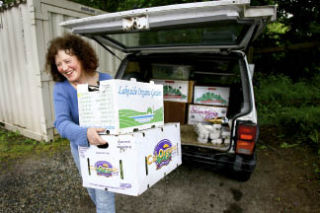Every Tuesday, five boxes of fresh produce are hand-delivered to the food bank at Helpline House by Chris Llewellyn, owner of Serendipity Organic Farm in Quilcene.
It’s only one of her 40 stops on the island that day, but it’s the one that reaches out to the most, well, mouths, then empty stomachs.
Helpline has started providing produce to its more than 170 weekly clients through a program called Community Supported Agriculture (CSA), which are subscriptions to food grown on sustainable farms such as Serendipity. To pay for the $440 weekly delivery of produce, Helpline is seeking donations from businesses and individuals.
Once Helpline meets its goal of 11 CSA subscriptions, each contribution will be rolled over into an existing program called Community Supported Pallets. At the same cost of $440, a full pallet of food (a six-week supply) of various staple foods is bought for the food bank. (Half pallets at $220 are also available at request).
“It’s a great idea by the food bank to have contributers buy the food from the farms,” said Llewellyn, who grew up on Bainbridge Island before buying the Quilcene farm several years ago. “It helps everyone involved, including farmers like me, and it promotes the need for open space. But most of all it provides quality food for people who need help.”
Marilyn Gremse, Helpline’s manager of volunteer services, said being able to offer fresh farm produce allows the food bank to provide a more nutritious bag of groceries to its clients.
She said the weekly demand has increased recently, jumping from 150 to 170 families during the last few weeks.
Each client, depending on the size of the family, gets about two bags of staples (cans of food, milk, bread, meat and eggs), and now a third bag of fresh produce. And no one is turned away.
“Generally, we are keeping up with the demand… we do the best we can,” Gremse said. “The island is very giving. It’s a hard time for people right now.
“Last week we had six new people come here on one day seeking a variety of services,” she continued. “That’s a lot for us. But people can always find food here… the cupboard’s never bare. And now, having fresh produce, it’s real special for everyone.”
Both Town & Country and Safeway markets are steady sources of donated food, plus many islanders donate money directly, Gremse said.
Cash is often used to buy staples from large wholesale food suppliers, such as Food Lifeline. And then there are the food drives, ranging from the 16,000 pounds of goodies supplied by the recent postal food drive to the Sunday school that had a peanut butter-and-jam drive.
And Woodward Middle School is expected sometime this week to drop off 2,180 items of food contained in cans and boxes.
“The community is very responsive,” Gremse said. “Everyone, including churches, schools, businesses and individuals, they all see the need and help out. We have 9th graders who come in and sort food for us.
“Some times are tougher for people than others,” she continued. “We’re in one of those right now. People think that everyone who lives here has plenty of money, but that’s not true. But we’re a small community, and people know what’s going on. They help out.”
Gremse said handing out food puts a smile on everybody’s face, but it also serves as an entree for the social worker.
“This is a very collaborative environment,” she said. “Once we get people in here, sometimes people who are hesitant to come in because they are embarrassed that they aren’t in a good way, we can explain what else we can offer them for long-term solutions to their problems.
“There have been some sudden job losses going on, but people won’t come in because the see us as a poverty agency. But we’re actually a community service agency that is capable of helping them in the short or long term — whatever the problem may be.”
Gremske said the agency contracted with the 46-acre Serendipity Farm because Llewellyn’s prices were better than others, and local farmers couldn’t provide the desired quantity.
“Our intention is to do what we can on the island,” she said, “but we have to get the best deal we can for our money.”


